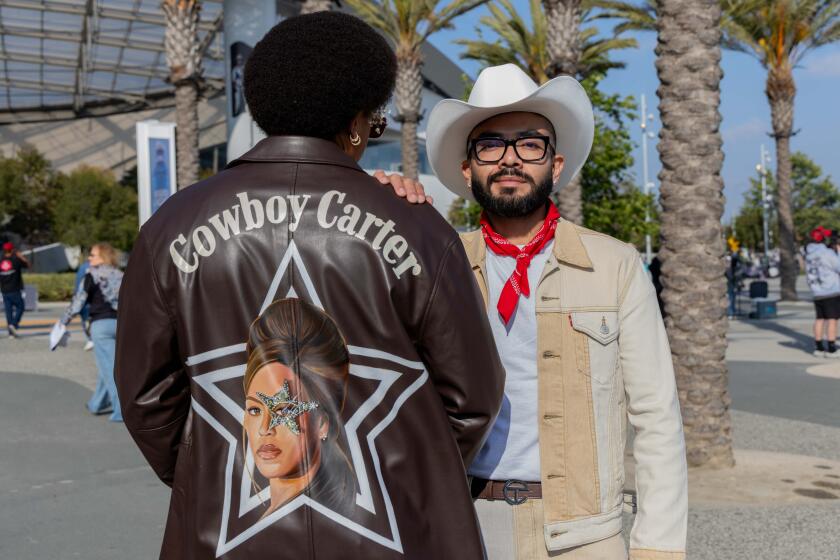‘American Eve’ by Paula Uruburu
- Share via
American Eve
Evelyn Nesbit, Stanford White, the Birth of the “It” Girl and the Crime of the Century
Paula Uruburu
Riverhead Books: 388 pp., $27.95
BY THE time she was 16, Evelyn Nesbit was the face of her age, a stunning beauty with a “heart-stopping scarlet stare,” a famous artist’s and photographer’s model whose image, in the earliest years of the 20th century, was used to sell everything from soap to chocolate, sewing machines to powdered toothpaste. She was the mistress of Stanford White, New York’s celebrated architect. White, the builder of an earlier Madison Square Garden and other grand Romanesque wedding-cake structures, was himself the focal point of obsession and crazy social envy of a young millionaire named Harry K. Thaw, heir to a Pennsylvania coke and railroad fortune.
Thaw was mad, a sadist who set about pursuing Nesbit as he had various other of White’s many young mistresses. Thaw more or less kidnapped Nesbit, whipped her habitually and forced her to tell him the nitty-gritty of her relationship with White. Nesbit, so young, couldn’t break free of either man; seeing no alternative, she married Thaw, and tension built and built until the inevitable tragedy occurred. On the baking night of June 25, 1906, Thaw approached White in White’s own backyard -- that’s to say on Madison Square Garden’s splendid roof terrace -- and calmly shot him three times in the face.
These are the bare bones of a story that haunts the American imagination and has inspired books, poems and movies. “Evelyn Nesbit had caused the death of one man and wrecked the life of another and from that he deduced that there was nothing in life worth having, worth wanting, but the thin embrace of her arms,” wrote E.L. Doctorow, evoking a male character’s fantasy in his novel “Ragtime.”
“Women wanted to be her; men wanted to own her. She became a maddening object of desire, and tragically, a victim of her own beguiling beauty during the ‘gaudy spree,’ which she would help bring to a stunningly shameful end,” writes Paula Uruburu in “American Eve.” The author identifies a pattern that has shaped the lives of many female stars: Clara Bow, Marilyn Monroe and, more recently, Lindsay Lohan and Britney Spears, who await their own endgames.
Nesbit was born in Tarentum, Pa., in 1884, or 1885, or maybe 1886. Nobody knows the exact year because Evelyn’s mother lied about her daughter’s age, probably to make the tantalizing girl-woman seem older than she was. Evelyn’s father, an unambitious lawyer, died when she was young, and the family knew hardship. Then magic occurred, the first moment in a grand and catastrophic story of transformation. Evelyn posed for a photograph, and people at once saw that she had a gift for it, some innate ability to adopt a look of tempting vacancy, “a mixture of ennui and expectation,” as Uruburu put it, that the camera adored and that would soon entrance much of the country. Evelyn discovered she could provide for her family, and her mother transported them to New York City in search of further fortune. Evelyn used her success as a model to move onto Broadway. She became a showgirl and drew the attention of the charismatic White, who collected pretty young women the way he did the European objets d’art that he sold to his millionaire clients.
Uruburu evokes the myth of Bluebeard, aptly enough, and tells the story of White’s seduction of Nesbit in chapters that are both thrilling and voluptuous. White was an architect. He created and controlled environments not only on commission but also for his own appetites and amusement. In an apparently dingy town house at West 24th Street (the building collapsed last year), he created a pleasure palace, a labyrinth of artful contrivance and enchantment. “The indirect lighting threw a suffused rosy glow over the entire setting -- the luxurious arabesque folds of floor-to-ceiling burgundy moiré drapes . . . and Oriental silk cushions the color of claret and cinnamon thrown promiscuously around the room,” writes Uruburu.
Higher in the house, in another room, White had positioned a “gorgeous swing with red velvet ropes.” As Evelyn approached the swing for the first time, White said, “let’s give this kiddie a ride,” and soon she was soaring through the air, piercing a paper ceiling decoration with well-aimed blows from her dainty foot. It was sexy, fetishistic stuff. Within weeks, White had arranged for Nesbit’s mother to be out of town and led the girl to yet another tiny room, still higher in the house, where a four-poster bed was surrounded by lights and beveled mirrors.
Lawyers would later argue that Nesbit must have been a willing accomplice, but Uruburu suggests that what occurred was moral and literal rape, after which Evelyn became White’s mistress. For White, the seduction had gone according to script. “She was not the first girl to ride on the red velvet swing,” Uruburu writes. “Nor did she have any say in how the relationship was to proceed. . . . But what did it matter to her, anyway? She was being treated like a sultana, and Stanny was her wizard godfather, giving her books and candy and marvelous gifts, promoting her career, helping her family, and doing it all while whistling snatches of Beethoven and remaking Manhattan to his liking.”
Soon, Evelyn was targeted by other admirers, by a dashing young newspaper artist soon to become an actor -- John Barrymore -- and by Thaw, whose craziness burns out of every picture ever taken of him. White tried to warn Evelyn about Thaw, but Evelyn was trapped. She had nobody to turn to. The sexual power she held over these two rich men was immense, but, essentially, she was their chattel. That’s the contradiction and the sadness in her story.
The two trials of Thaw, in which Nesbit, having been promised a million dollars, testified on her husband’s behalf, were a sensation: Uruburu tells this part of the story well enough, though without the breathless, sensual panache of the earlier sections. Thaw was acquitted by reason of insanity and gained his freedom some years later, while Nesbit, needless to say, never saw her money and lived a brave, hardscrabble life of notoriety thereafter. She was a fallen idol, though her own books, different versions of her story written at various times, show her to be clever, shrewd and self-aware -- a good writer, actually. “The tragedy wasn’t that Stanford White died, but that I lived,” she said in 1934; she sold her story to Hollywood for a movie starring the young Joan Collins in the 1950s. She died, in 1967, at a nursing home in Santa Monica.
The book’s subtitle, “Evelyn Nesbit, Stanford White, the Birth of the ‘It’ Girl and the Crime of the Century,” loads Nesbit’s story with more promotional sound bites than it really needs or can bear, and the writing in “American Eve” works best when sticking close to the devouring intimacy of the Nesbit-White-Thaw triangle.
Nesbit was a catalyst for excitement and disaster, and, in the end, a representative of change. I’m not sure, though, that we want to remember her in the strained symbolic ways sometimes suggested in “American Eve,” in which Uruburu writes: “Eventually spread out like a crazy quilt over six decades of the twentieth century, the details of the rest of her life illuminate not only her own personal strengths and weaknesses, but also the brightest and darkest aspects of the collective American Dream she embodied.”
Photographs of Nesbit (and there are many here, some famous, others completely unknown and unearthed by Uruburu) do show a face that seems startlingly contemporary; no doubt, a part of Nesbit’s continuing magnetism is that she was an unwitting herald of sexual modernity. Still, I think Uruburu needlessly strains to oversell what she has in her hands, a tale oft-told, but never as diligently and lovingly researched as here, an operatic story -- not of celebrity or the American Dream but of sex, class and power. *
More to Read
Sign up for The Wild
We’ll help you find the best places to hike, bike and run, as well as the perfect silent spots for meditation and yoga.
You may occasionally receive promotional content from the Los Angeles Times.










